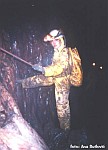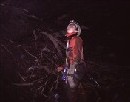
The town of Ogulin
Photos
from speleoorietation in Djula-Medvedica cave system

Djulin ponor, 1930.
Ogulin,
Matica hrvatska
Karst
Waters Intitute: Top Ten List of Endangered Karst Ecosystems
Ogulin Karst, Croatia is located in the northern Dinaric karst area and is
part of the Black Sea drainage. The lowest point of known underground
channels is 83.5 m deep in the Djula-Medvedica cave system. The high
biodiversity of this karst ecosystem is likely due to rich organic input,
permanent groundwater habitats, high diversity of surface streams and the
changing of water flow directions in the area. It is one of the richest
underground biodiversity sites in the world with more than 20 cave-limited
species, including several endemics. The karst ecosystem is threatened
from sewage and waste dumping, water extraction for the Gojak
Hydroelectric Power Plant which causes the old parts of the river beds to
maintain water only during extremely high water levels, the construction
of highways and gasoline pipelines.
|
|
The results of the explorations
1984-1987.
 From
1984. to 1987. explorations were performed by Speleological section
Velebit, Zagreb. The average temperature in the cave system
Djula-Medvedica is 9 oC. The difference in altitude between the highest
and lowest point is 83.5 m. The cave system is divided into 3 main parts.
The first part is a maze of passages between Djulin ponor and the entrance
parts of the cave Medvedica. The entrance of Medvedica is 310 m away from
the entrance of Djula. During the period of a low water level this is a
dry part of the cave. This part of the cave system is a sort of a filter
of the river Dobra, and this is the main cause of frequent floods. In the
second part called Velika pletenica (a big braid) there is a main channel
in the north direction. It is the most elongated part of the cave with
several water flows and lakes, a part of which is very badly polluted. The
third part of the cave consists of several big channels formed by a strong
water flow in the SW-NE direction. Unlike the first two parts, the third
one is not badly polluted and the water is rather clean. From
1984. to 1987. explorations were performed by Speleological section
Velebit, Zagreb. The average temperature in the cave system
Djula-Medvedica is 9 oC. The difference in altitude between the highest
and lowest point is 83.5 m. The cave system is divided into 3 main parts.
The first part is a maze of passages between Djulin ponor and the entrance
parts of the cave Medvedica. The entrance of Medvedica is 310 m away from
the entrance of Djula. During the period of a low water level this is a
dry part of the cave. This part of the cave system is a sort of a filter
of the river Dobra, and this is the main cause of frequent floods. In the
second part called Velika pletenica (a big braid) there is a main channel
in the north direction. It is the most elongated part of the cave with
several water flows and lakes, a part of which is very badly polluted. The
third part of the cave consists of several big channels formed by a strong
water flow in the SW-NE direction. Unlike the first two parts, the third
one is not badly polluted and the water is rather clean.
 Because of water
flows, the cave decorations are very scarce and erosive features like
whirpool slugs are very common. The level of water often increases very
rapidly as a consequence of heavy rainfall and snow melting. While the
water level is higher, a bigger part of the cave gets completely filled
with water.
Because of water
flows, the cave decorations are very scarce and erosive features like
whirpool slugs are very common. The level of water often increases very
rapidly as a consequence of heavy rainfall and snow melting. While the
water level is higher, a bigger part of the cave gets completely filled
with water.
The
easternmost part of the cave ends in a siphon and indicates that some
water flows of the underground Dobra are directed toward the spring
Bistrac. The main direction of the channels and of the water flow in the
cave Medvedica is toward the north, and Gojacka Dobra is in the same
direction. The strongest water flow in the third part of the cave comes
from the direction of the surface Dobra sinkhole at Okruglica and
Hreljin.
The pollution of the cave system
 The cave system Djula-Medveica is a typical example of human negligence
of environment. It is situated under a town Ogulin and is exposed to
permanent polluting. The entrance parts of Djula and especially Medvedica
are the most polluted parts. The cave is polluted with sewage, drawing
through the surface and with the river Dobra, especially during the period
of the high water level. There are several sorts of waste: artificial
solid waste (metal, glass, rubber, and plastic materials), biological waste
(wood trunks and branches, dead organisms, microflora and microfauna in
water), chemical waste (oil, tar, detergents). The consequences of such
pollution are following: sinkholes set blocked up and threaten to flood,
the underground is mechanically and bacterially contaminated. The final
consequence is that the underground space is being damaged. It all
directly influence the inhabitants and the living world od Ogulin region. The cave system Djula-Medveica is a typical example of human negligence
of environment. It is situated under a town Ogulin and is exposed to
permanent polluting. The entrance parts of Djula and especially Medvedica
are the most polluted parts. The cave is polluted with sewage, drawing
through the surface and with the river Dobra, especially during the period
of the high water level. There are several sorts of waste: artificial
solid waste (metal, glass, rubber, and plastic materials), biological waste
(wood trunks and branches, dead organisms, microflora and microfauna in
water), chemical waste (oil, tar, detergents). The consequences of such
pollution are following: sinkholes set blocked up and threaten to flood,
the underground is mechanically and bacterially contaminated. The final
consequence is that the underground space is being damaged. It all
directly influence the inhabitants and the living world od Ogulin region.
References:
- Marijan Čepelak, Špiljski sustav Đula-Medvedica, Speleolog, 1984-1985,
2-24, Zagreb.
- Boris Vrbek, Some characteristics of silt of subterranean system of
Djula-Medvedica in Ogulin, IAH 21st congress, Karst Hydrogeology and Karst
Environment Protection, 1988, Gulin, China.
- Eduard Kireta, Miron Kovačić, Speleološka istraživanja ogulinskog krša,
Speleološki odsjek Velebit, Zagreb, 1987.
- Mirko Malez, Pećina Medvedica (Ogulin), Geološki vjesnik, X, 1956.,
Zagreb.
- Mirko Malez, Đulin ponor u Ogulinu, Geološki vjesnik, VIII-IX, 1954/55.,
Zagreb.
- Josip Poljak, Geomorfologija i hidrografija Ogulina i oglinskog Zagorja.
Glasnik hrv.prir.društva, XXXVII-XXXVIII, 1926., Zagreb.
- Josip Poljak, Pećine okolice Ogulina, V. Paklenice i Zameta. Rasprave
geol.inst.kralj.Jug., sv.5, 1935.
|